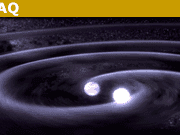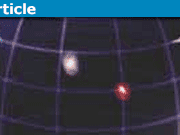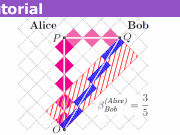Oppenheimer-Snyder Model of Gravitational Collapse: Implications
In the last article in this series, we finished up with a metric for the Oppenheimer-Snyder collapse:
$$
ds^2 = – d\tau^2 + A^2 \left( \eta \right) \left( \frac{dR^2}{1 – 2M \frac{R_-^2}{R_b^2} \frac{1}{R_+}} + R^2 d\Omega^2 \right)
$$
Now we will look at some of the implications of this metric.
First, let’s review what we already know: ##\tau## is the proper time of our comoving observers, who follow radial timelike geodesics starting from mutual rest for all values of ##R## at ##\tau = 0##. ##R## labels each geodesic with its areal radius ##r## at ##\tau = 0##. ##\eta## is a cycloidal time parameter that ranges from ##0## to ##\pi##; ##\eta = 0## is the starting point of each geodesic at ##\tau = 0##, and ##\eta = \pi## is the point at which each geodesic hits the singularity at ##r = 0##. Inside the collapsing matter, ##\eta## is a function of ##\tau## only, but in the vacuum region outside the collapsing matter, ##\eta## is a function of both ##\tau## and ##R##.
Now let’s look at the geometry of the hypersurfaces of constant ##\tau##, for ##\tau > 0##. We saw that, for ##\tau = 0##, this geometry is what we expected from our initial discussion: a portion of a 3-sphere joined to a Flamm paraboloid by a 2-sphere boundary at areal radius ##R_b##. That is what the factor inside the parentheses in the spatial part of the metric above describes. So we might initially think that that same geometry applies to all surfaces of constant ##\tau##.
Unfortunately, however, that’s not the case. Inside the collapsing matter, it is true that each surface of constant ##\tau## is a portion of a 3-sphere, but with increasing spatial curvature and bounded by 2-spheres of decreasing areal radius (the formula for the decrease, but in terms of ##\eta##, not ##\tau##, can be found by plugging ##R = R_b## into the formula for ##r## in terms of ##R## in the previous article). But outside the collapsing matter, the Flamm paraboloid geometry (with the areal radius of its inner boundary 2-sphere decreasing with ##\eta##) is the geometry of surfaces of constant ##\eta##, not surfaces of constant ##\tau##. And, as we saw in the previous article, these surfaces are not the same, because, as noted above, in the vacuum region, ##\eta## is a function of both ##\tau## and ##R##.
Along surfaces of constant ##\tau##, as we can see from the formula for ##\tau## in the previous article, ##\eta## decreases as ##R## increases. That means that the scale factor ##A(\eta)## increases as ##R## increases. This means that ##r / R## increases as ##R## increases: in other words, the areas of 2-spheres increase *faster* with ##R## than they would in a Flamm paraboloid geometry. I’m not sure if there is a simple description of this geometry; it might be that it can be described as a paraboloid with a different “lift” function than the standard Flamm paraboloid.
Next, let’s look at the locus of the singularity at ##r = 0##. This is at ##\eta = \pi##, as noted above, but in terms of ##\tau##, this becomes
$$
\tau = \frac{\pi}{2} \sqrt{\frac{R_+^3}{2M}}
$$
The presence of ##R_+## in this formula tells us that this value of ##\tau## is constant everywhere in the collapsing matter, but increases with ##R## in the vacuum region. Or, to put it another way, all of the comoving observers inside the collapsing matter take the same proper time to reach the singularity; but outside the collapsing matter, comoving observers take longer to reach it the further away they are, with the proper time increasing as the ##3/2## power of ##R##.
Next, let’s consider a question that you might have been wanting to ask for some time now: where is the event horizon in all this? We can see that the metric above is manifestly nonsingular for ##\eta < \pi##, so there is no way to tell from the line element directly where the horizon is. We do know that in the exterior vacuum region, the horizon is at ##r = 2M##, and plugging this into the formula for ##r## gives
$$
R_H = \frac{4M}{1 + \cos \eta}
$$
For the surface of the infalling matter, we can set ##R_H = R_b## in the above to obtain
$$
\eta_H = \cos^{-1} \left( \frac{4M}{R_b} – 1 \right)
$$
and therefore
$$
\tau_H = \frac{1}{2} \sqrt{\frac{R_b^3}{2M}} \left[ \cos^{-1} \left( \frac{4M}{R_b} – 1 \right) + \sqrt{\frac{8M}{R_b} – \frac{16M^2}{R_b^2}} \right]
$$
Note that this formula shows that we must have ##R_b > 2M##, so that the argument of the inverse cosine is less than ##1##, and that as ##R_b \to \infty##, ##\eta_H \to \pi## and ##\tau_H \to \infty##, as we would expect.
As we move to the future of the event at ##\eta_H##, where the surface of the infalling matter crosses the horizon, ##R_H## increases, so in these coordinates, the horizon is not vertical but is inclined outward. This, of course, just reflects the fact that geodesics with larger and larger ##R## take longer and longer to reach the horizon.
To the *past* of the event at ##\eta_H##, we can use the fact that the horizon is generated by radially outgoing null geodesics. Setting ##ds = 0## in our line element and taking advantage of the fact that this portion of the horizon is entirely within the collapsing matter, we have
$$
d\tau = A (\eta) \frac{1}{\sqrt{1 – \frac{2M R^2}{R_b^3}}} dR
$$
Inside the collapsing matter, we have ##d\tau = \sqrt{R_b^3 / 2M} A(\eta) d \eta##, so we can rewrite this as
$$
d \eta = \frac{1}{\sqrt{\frac{1}{k} – R^2}} dR
$$
where we have returned to our previous notation ##k = 2M / R_b^3##. This integrates to
$$
\eta = \sin^{-1} \left( R \sqrt{k} \right) + \eta_0
$$
The value of ##\eta_0## is what we are looking for since this is the value of ##\eta## for the horizon at ##R = 0##, i.e., the value of ##\eta## at which the horizon forms at the center of the collapsing matter and starts expanding outward. We can obtain it by plugging in ##R = R_b## and ##\eta = \eta_H##:
$$
\eta_0 = \eta_H – \sin^{-1} \left( \sqrt{\frac{2M}{R_b}} \right)
$$
The corresponding value of ##\tau## is
$$
\tau_0 = \frac{1}{2} \sqrt{\frac{R_b^3}{2M}} \left( \eta_0 + \sin \eta_0 \right)
$$
We won’t try to expand this since it would involve some tedious algebra involving trigonometric identities. However, we can read off the qualitative behavior easily enough. As ##R_b \to \infty##, we have ##\eta_0 \to \eta_H##. This might seem counterintuitive, but in fact, it just means that, for collapses of larger and larger objects, the time between the horizon forming at the center, ##r = 0##, and the surface of the matter crossing the horizon at ##r = 2M##, is a smaller and smaller fraction of the total time the collapse takes. The proper time ##\tau## between those events, however, increases as ##R_b## increases.
The more interesting case is ##R_b \to 2M##, for which we have ##\eta_0 \to \eta_H – \pi / 2##. Since we have ##\eta_H \to 0## in this limit, we see that in this case, the horizon forms at the center, ##r = 0##, at a time that is before the collapse actually starts! Again, this seems counterintuitive, but it is simply a consequence of the fact that the event horizon is globally defined; you have to already know the entire future of the spacetime to know where it is. And in our model, we do know that: we have declared by fiat that the object will start collapsing at ##\tau = 0## (or ##\eta = 0##).
To put this another way, the definition of ##\eta_0## is that it is the time at which light signals must be emitted from ##r = 0## in order to reach the surface of the collapsing matter just as the matter reaches ##r = 2M##. And since we are looking at the limit ##R_b \to 2M##, the collapsing matter is at ##r = 2M## at ##\eta = 0##, so of course light signals must be emitted from ##r = 0## before ##\eta = 0## in order to just reach the surface at ##\eta = 0##. The above equation with ##R_b = 2M## plugged in just tells us how much before.
In summary, we can see that the mathematical details confirm what we initially came up with based on general physical principles. We have a collapsing matter region that looks like a portion of an FRW closed universe, joined at its boundary to a Schwarzschild vacuum region, and we have an event horizon that forms at the center of the collapsing matter, expands outward until it reaches the surface of the collapsing matter just as that surface passes ##r = 2M##, and then stays at ##r = 2M## thereafter. All of the collapsing matter reaches ##r = 0## at the same instant, but freely falling objects outside the collapsing matter take longer to reach ##r = 0## the further away they are when they start to fall. And, as we now know from numerical simulations, these qualitative features remain basically the same even for collapses that do not meet the highly idealized conditions of our model: the matter may have nonzero pressure and the collapse may not be spherically symmetric, but it does not change the basic features of the model. So this model is indeed a good one to use to understand the basic features of gravitational collapse.
- Completed Educational Background: MIT Master’s
- Favorite Area of Science: Relativity










Leave a Reply
Want to join the discussion?Feel free to contribute!